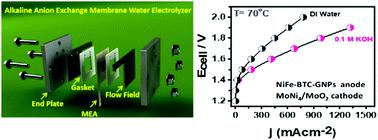当前位置:
X-MOL 学术
›
Energy Environ. Sci.
›
论文详情
Our official English website, www.x-mol.net, welcomes your feedback! (Note: you will need to create a separate account there.)
Graphene-nanoplatelets-supported NiFe-MOF: high-efficiency and ultra-stable oxygen electrodes for sustained alkaline anion exchange membrane water electrolysis
Energy & Environmental Science ( IF 32.5 ) Pub Date : 2020-05-27 , DOI: 10.1039/d0ee00877j Pandiarajan Thangavel 1, 2, 3, 4, 5 , Miran Ha 1, 2, 3, 4, 5 , Shanmugasundaram Kumaraguru 6, 7, 8 , Abhishek Meena 1, 2, 3, 4, 5 , Aditya Narayan Singh 1, 2, 3, 4, 5 , Ahmad M. Harzandi 1, 2, 3, 4, 5 , Kwang S. Kim 1, 2, 3, 4, 5
Energy & Environmental Science ( IF 32.5 ) Pub Date : 2020-05-27 , DOI: 10.1039/d0ee00877j Pandiarajan Thangavel 1, 2, 3, 4, 5 , Miran Ha 1, 2, 3, 4, 5 , Shanmugasundaram Kumaraguru 6, 7, 8 , Abhishek Meena 1, 2, 3, 4, 5 , Aditya Narayan Singh 1, 2, 3, 4, 5 , Ahmad M. Harzandi 1, 2, 3, 4, 5 , Kwang S. Kim 1, 2, 3, 4, 5
Affiliation

|
Practical hydrogen production using high-efficiency, low-cost, and stable oxygen electrodes is crucial for a sustainable clean energy future. Herein we report a graphene-nanoplatelets-supported (Ni,Fe) metal–organic framework (MOF) as a superior and ultra-durable (>1000 h) anode for alkaline water electrolysis. The MOF on carbon-fiber paper electrodes requires an overpotential η = 220 mV to achieve a current density j = 10 mA cm−2 (η = 180 mV on nickel foam for j = 20 mA cm−2) with a Tafel slope of 51 mV per decade, high turnover frequency (1.22 s−1), high faradaic efficiency (99.1%), and long-term durability of >1000 h in continuous electrolysis. In an alkaline anion exchange membrane water electrolyzer (AAEMWE), it exhibits a record current density of 540 mA cm−2 at 1.85 V at 70 °C, outperforming the state-of-the-art Pt/C//IrO2. A breakthrough strategy introduced in membrane electrode assembly fabrication by extending the electrical contact with an aqueous electrolyte offers an additional OH− transport pathway to regenerate the original conductivity of the AAEMWE in continuous electrolysis, without any significant change in the pH of the electrolyte. These findings open up durable, high-performance AAEMWE and direct solar-to-fuel conversion, especially to replace high-cost proton exchange membrane water electrolysis that already works with ultra-pure water.
中文翻译:

石墨烯-纳米片支持的NiFe-MOF:高效和超稳定的氧电极,用于持续的碱性阴离子交换膜水电解
使用高效,低成本和稳定的氧电极进行实际制氢对于可持续的清洁能源未来至关重要。本文中,我们报道了石墨烯-纳米片支持的(Ni,Fe)金属-有机骨架(MOF),作为碱性水电解的优异且超耐用(> 1000 h)的阳极。碳纤维纸电极上的MOF需要超电势η = 220 mV,以实现电流密度j = 10 mA cm -2(对于j = 20 mA cm -2,镍泡沫上的η = 180 mV ),塔菲尔斜率是51每十年mV,高周转频率(1.22 s -1),法拉第效率高(99.1%),连续电解中> 1000 h的长期耐久性。在碱性阴离子交换膜水电解器(AAEMWE)中,它在70°C时于1.85 V时表现出创纪录的电流密度为540 mA cm -2,优于最新的Pt / C // IrO 2。在膜电极组件的制造中引入的突破策略通过用含水电解质报价延伸的电接触的附加的OH -连续电解过程中再生AAEMWE原始电导率的输送途径,而电解液的pH值没有任何显着变化。这些发现开辟了持久的高性能AAEMWE和直接将太阳能转化为燃料的方法,特别是取代了已经可以与超纯水一起使用的高成本质子交换膜水电解技术。
更新日期:2020-05-27
中文翻译:

石墨烯-纳米片支持的NiFe-MOF:高效和超稳定的氧电极,用于持续的碱性阴离子交换膜水电解
使用高效,低成本和稳定的氧电极进行实际制氢对于可持续的清洁能源未来至关重要。本文中,我们报道了石墨烯-纳米片支持的(Ni,Fe)金属-有机骨架(MOF),作为碱性水电解的优异且超耐用(> 1000 h)的阳极。碳纤维纸电极上的MOF需要超电势η = 220 mV,以实现电流密度j = 10 mA cm -2(对于j = 20 mA cm -2,镍泡沫上的η = 180 mV ),塔菲尔斜率是51每十年mV,高周转频率(1.22 s -1),法拉第效率高(99.1%),连续电解中> 1000 h的长期耐久性。在碱性阴离子交换膜水电解器(AAEMWE)中,它在70°C时于1.85 V时表现出创纪录的电流密度为540 mA cm -2,优于最新的Pt / C // IrO 2。在膜电极组件的制造中引入的突破策略通过用含水电解质报价延伸的电接触的附加的OH -连续电解过程中再生AAEMWE原始电导率的输送途径,而电解液的pH值没有任何显着变化。这些发现开辟了持久的高性能AAEMWE和直接将太阳能转化为燃料的方法,特别是取代了已经可以与超纯水一起使用的高成本质子交换膜水电解技术。

























 京公网安备 11010802027423号
京公网安备 11010802027423号